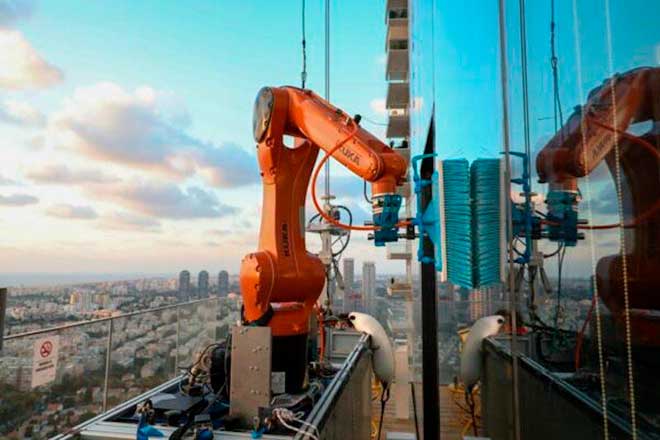Skyline Robotics is automating the cleaning of skyscraper facades worldwide - a task that was previously performed manually for more than 100 years. Skyline Robotics from Israel is taking the cleaning of glass facades to a new level. The Skyline Robotics team has developed Ozmo to automate window cleaning: this system combines KUKA's KR AGILUS with a computer image processing system, artificial intelligence (AI), and machine learning technologies. What previously required three to four months of hard physical work, Ozmo does automatically in just under half the time.
The most significant improvement of this new development: the system ensures safety by replacing humans on the work platform. Manual facade cleaning usually requires three to four workers: Two clean on the work platform, one person on the roof of the building, and sometimes another on the ground. The Ozmo requires just one person to operate the work platform, the power and water supply, and the crane. During this time, the robot is busy cleaning the windows.
Five years of preparation for perfect cleaning results
The Ozmo system was designed to fit into the existing building maintenance unit (BOM) infrastructure, using electricity and water from the building itself to provide electricity and water. Part of the work platform is a table with various sensors and computers. On top is a robot arm with a Lidar camera (Lidar stands for light imaging, detection and range, and the use of laser pulses). The Lidar camera uses Class 1 lasers, which are harmless to humans. Once this table is attached to an existing façade cleaning work platform, the system is ready.
The Skyline team has been working on the Ozmo project for five years. They overcame various technological hurdles and took iterative steps toward integrating all the necessary components and features. It includes the KR AGILUS industrial robot and its programming, which allows the robotic arm to mimic human movements when cleaning windows.
How Ozmo sees, touches, and thinks
The robot arm interacts with a lidar camera, which allows the robot to "see," with a force and torque sensor on the end of the brush, which is a "sense of touch." The system's software acts like a "brain," collecting data from various cameras and sensors to optimize path planning at a rate of about 200 times per second as Ozmo automatically descends the facade of a skyscraper.
From weather-resistant to world-class
The heart of the Ozmo system is the KR AGILUS in a waterproof version in a tank with artificial intelligence software that allows it to be used for window cleaning. Skyline Robotics has developed an algorithm that transfers force control and other variables back to the robot. It will enable the robot to control the amount of pressure the robot exerts on the window pane.
The radius of action of the facade cleaning robot is 1.10 meters. Skyline chose KUKA because KR AGILUS could handle outdoor problems, whereas most competitors could not. In addition, there is confidence in the KUKA brand and the world-class team behind it. The fact that these robots are IP67 rated, very reliable, and move on six axes was also a factor in Skyline Ro-botics' decision. After all, Ozmo also has to cope with the complex geometric shapes of the facades of some skyscrapers.
The radius of action of the façade cleaning robot is 1.10 meters. The main reason why Skyline chose KUKA was that KR AGILUS could handle outdoor challenges, whereas most competitors cannot. In addition, there is confidence in the KUKA brand and the world-class team behind it. The fact that these robots are IP67 rated, very reliable, and move on six axes was also a factor in Skyline Ro-botics' decision. After all, Ozmo also has to cope with the complex geometric shapes of the facades of some skyscrapers.
More freedom with the KR C5 microcontroller for small robots
The KUKA KR C5 small robot microcontroller in the Ozmo system makes a significant contribution to meeting the various weight limits of working platforms worldwide. The KR C5 micro weighs only 9.8 kg, which is 16 kilograms lighter than similar controllers and significantly less space. So in some cases, Sky-line Robotics can accommodate multiple KR AGILUS on a single work platform, even with more stringent weight restrictions.
Even gusts of wind do not throw Ozmo off balance.
The technologies integrated into Ozmo are highly advanced, especially the software and first-class hardware components. On the one hand, they allow Skyline Robo-tics to control and constantly adapt the robot's movements during cleaning. And on the other hand, they will enable you to stabilize the work platform with the robot in real-time. It is not easy because unforeseen events, such as wind gusts or crane kinematics are always expected. It can cause one side of the platform to tilt more than the other.
But Ozmo can detect these variables and compensate for them immediately. It ensures the highest cleaning quality and the most efficient path. Ozmo uses the KR AGILUS and its ability to act as a counteracting force for the unstabilized work platform to stabilize it. The robotic arm remains attached to the building window for another half-second to prevent the work platform from swaying.
It all comes down to experience and strong partners
Many robotics companies want to gain a foothold in the automated façade cleaning business. But this business is very complex and mathematical, especially in terms of artificial intelligence and machine learning. You can't just put a robot on a work platform and think that's all it needs.
Speaking of the proof-of-concept stage, Skyline Robotics is now getting widespread support. The company announced the successful completion of a $6.5 million funding round.
With buildings getting taller and a shrinking workforce, the creation of Skyline is timely and necessary.




